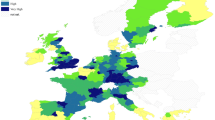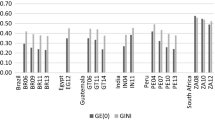Abstract
In measuring human development, one of the main concerns relates to the inclusion of a measure that penalizes inequalities in the distribution of achievements across the population. Using indicators from nationally representative household surveys and census data, this paper proposes a straightforward methodology to estimate a household-based distribution-sensitive human development index aggregated through generalized means. The evidence shows that the losses in human development due to inequality reach up 22, 29 and 57% in Mexico, Peru and Nicaragua, respectively. Among dimensions, the loss in the income index reaches up 61% in Nicaragua, while the education index appears as the most sensitive in the case of Mexico and Peru, with a percentage of loss between 38 and 48%. The importance of household-level calculations is highlighted when we compare the indices computed from the entire distribution with those existing indices computed for quintiles of the distribution, which minimizes the losses due to inequality. Overall, the estimations evidence a higher sensitivity of the index to inequality, and therefore an important space for public action to reduce inequality that could involve positive development returns.





Similar content being viewed by others
Notes
Technical details are presented in UNDP (1995).
This principle establishes that for two equal distributions, namely x and y, and a bistochastic matrix C, the welfare in x will be lower than in y whether y becomes smoother than x (x < y C). See Kolm (1977).
The inequality discounted using generalized means is equivalent to the level discounted using the Atkinson’s (1970) unidimensional inequality measure I ε, so that μα(·) can be also expressed as: \( \mu_{\alpha } ( \cdot ) = \mu ( \cdot )[1 - I_{\varepsilon } ( \cdot )] \), with \( I_{\varepsilon } ( \cdot ) = 1 - [\mu_{\alpha } ( \cdot )/\mu ( \cdot )] \), where a larger gap between the generalized mean and the arithmetic mean implies a higher inequality. By doing so, the overall index resulting in (5) is interpreted as the traditional index in (1) discounted by the level of inequality as measured by the Atkinson measure (Foster et al. 2005 show how to extend the Atkinson’s measure to the multidimensional space).
The association between dimensions is related to the notions of complementarity and substitutability, broadly analyzed by Bourguignon and Chakravarty (2003). They proposed a two-dimensional poverty measure based on a CES function that allows a degree of substitution between dimensions.
The 2010 HDR proposed a new measure of human development that also penalizes the inequalities in the distribution of achievements. As the new index was named inequality-adjusted human development index (IAHDI), we decided to include the official acronym to our household-based index, thus being HB-IAHDI.
The 2002 HDR for Mexico also calculated this class of indices by states using a sample from the census (UNDP 2003); the 2009 HDR for Argentina estimates the same indices using microdata (UNDP 2009a); and based on an earlier version of this paper the Latin American and the Caribbean HDR 2010 calculate the indices for 18 countries using standardized household surveys (UNDP 2010).
Rescaling suggests a net difference between the income in surveys and national accounts that should be owned by both private and public sectors and used, for instance, in savings, investments in physical and human capital, and redistribution through public goods or social protection policies. The way in which the difference is adjusted—mainly related to income under-reporting in surveys—suggests different distributive effects, and some methods of adjustment have been proposed in literature in order to obtain figures closer to reality (see for example the work by Altimir 1987). In this paper, we prefer to take the view that adjustment to national accounts is distributional neutral as the methods developed are somewhat and unavoidably arbitrary. This is also supported by the idea that the distributional net effect of taxation and public expenditure and public goods provision in Latin America is very low (ECLAC 2010).
There are significant conceptual problems in adjusting household income to minimum and maximum reference thresholds, and the results could be sensitive to these adjustments, as many authors have pointed out (see for example the discussion by Alkire and Foster 2010). First, in dealing with survey data we face the presence of negative or zero values, and thus the calculation of the income index will suffer the loss of observations as these are being considered as missing values. In searching the best way to address this problem we decided to transform the observed negative and zero data to a strictly positive threshold of $100 as proposed by UNDP; however, at this stage appears a second problem: the presence of observations strictly positive but below the threshold. The number of these observations for the countries analyzed in this paper is lower, and there are no significant differences in the resulting income indices if we adjust to $100 or to a different value, so that we prefer to maintain the official threshold.
For comparative purposes, the maximum value of 16 years of schooling corresponds to at least four completed years of tertiary education. For instance, the norm indicates that Mexican individuals have to complete 6 years of primary, 3 years of lower secondary, 3 years of upper secondary, and between 4 and 5 years of tertiary education. This implies a maximum schooling of about 16–17 years. In Peru, however, the norm indicates that population have to complete 6 years of primary, 5 years of secondary and 5 years of tertiary education, so that the maximum schooling is 16 years.
See for example Gakidou and King (2000).
The higher historically observed value according to the MDG indicators.
In the case of the multiplicative form of the generalized mean, when ɛ = 1 (or α = 0), the household i’s level of development is expressed as: \( d_{i} = \left[ {\prod {yi_{i} ,ei_{i} ,hi_{i} } } \right]^{\frac{1}{3}} \).
Due to the lack of child survival data at the household level, UNDP (2010) followed a regression approach to estimate the probability of access to water and sanitation, based on several socioeconomic indicators. The estimated probabilities were averaged and the final value was interpreted as a proxy for health. The results for 18 Latin American countries show that the distribution of the scores was highly sensitive to inequality, particularly in Central America. In the case of the countries analyzed here, the results show that when going from ɛ = 0 to ɛ = 2 Nicaragua has the highest loss in the health dimension (64%), followed by Peru (26%) and Mexico (12%).
References
Alkire, S., & Foster, J. (2010) Designing the inequality-adjusted human development index (HDI). OPHI working paper no. 37, University of Oxford.
Altimir, O. (1987). Income distribution statistics in Latin America and their reliability. Review of Income and Wealth, 33(2), 111–155.
Anand, S., & Sen, A. K. (1995). Gender inequality in human development: Theories and measurement. HDRO occasional paper no. 19. New York: UNDP. http://hdr.undp.org/en/reports/global/hdr1995/papers/sudhir_anand_amartya_sen.pdf.
Arim, R., & Vigorito, A. (2009). Human development and inequality: The adjusted human development index. Background paper for the Regional Human Development Report for Latin America and the Caribbean 2010.
Atkinson, A. B. (1970). On the measurement of inequality. Journal of Economic Theory, 2(3), 244–263.
Bourguignon, F., & Chakravarty, S. R. (2003). The measurement of multidimensional poverty. Journal of Economic Inequality, 1(1), 25–49.
Cherchye, L., Ooghe, E., & Puyenbroeck, T. V. (2008). Robust human development rankings. Journal of Economic Inequality, 6(4), 287–321.
ECLAC. (2010). Economic Survey of Latin America and the Caribbean 2009–2010. Santiago: United Nations.
Foster, J., Greer, J., & Thorbecke, E. (1984). A class of decomposable poverty measures. Econometrica, 52(3), 761–766.
Foster, J., Lopez-Calva, L. F., & Szekely, M. (2005). Measuring the distribution of human development: Methodology and an application to Mexico. Journal of Human Development, 6(1), 5–25.
Foster, J., McGillivray, M., & Seth, S. (2009). Rank robustness of composite indices. OPHI working paper no. 26, University of Oxford. http://www3.qeh.ox.ac.uk/pdf/ophiwp/OPHIwp26.pdf.
Gakidou, E., & King, G. (2000). An individual-level approach to health inequality: Child survival in 50 countries. Discussion paper series no. 18. Geneva: World Health Organization. http://polmeth.wustl.edu/media/Paper/king00c.pdf.
Grimm, M., Harttgen, K., Klasen, S., & Misselhorn, M. (2008). A human development index by income groups. World Development, 36(12), 2527–2546.
Harttgen, K., & Klasen, S. (2010). A household-based human development index. Human Development Research Paper 2010/22. New York. http://hdr.undp.org/en/reports/global/hdr2010/papers/HDRP_2010_22_rev.pdf.
Hicks, D. A. (1997). The inequality-adjusted human development index: A constructive proposal. World Development, 25(8), 1283–1298.
Kolm, S.-C. (1977). Multidimensional egalitarianisms. Quarterly Journal of Economics, 91(1), 1–13.
Sen, A. K. (1976). Poverty: An ordinal approach to measurement. Econometrica, 44(2), 219–231.
Seth, S. (2009). Inequality, interactions and human development. Journal of Human Development and Capabilities, 10(3), 375–396.
UNDP. (1995). Human development report 1995. Gender and human development. New York: Oxford University Press.
UNDP. (2003). Informe sobre Desarrollo Humano México 2002. Mexico: Mundi-Prensa.
UNDP. (2007). Human development report 2007/2008. Fighting climate change: Human solidarity in a divided world. New York: Palgrave Macmillan.
UNDP. (2009a). Aportes para el desarrollo humano en Argentina 2009. Buenos Aires: PNUD.
UNDP. (2009b). Human development report 2009. Overcoming barriers: Human mobility and development. New York: Palgrave Macmillan.
UNDP. (2010). Human development report for Latin America and the Caribbean 2010. Acting on the future: Breaking the inequality transmission of inequality. Costa Rica: Editorama.
Acknowledgments
The authors would like to thank Sabina Alkire, James Foster, participants at the 2010 Annual HDCA Conference in Amman, Jordan, the HDRO-UNDP Meeting on Multidimensional Poverty and Inequality held in New York, and anonymous referees for very useful comments. We also want to thank the support of the World Bank through the Summer Initiative for Research on Poverty, Inequality and Gender (SiRPiG) in the Poverty and Gender Unit, PREM-LAC. The views expressed here do not necessarily represent those of the World Bank or the United Nations Development Programme.
Author information
Authors and Affiliations
Corresponding author
Rights and permissions
About this article
Cite this article
Lopez-Calva, L.F., Ortiz-Juarez, E. A Household-Based Distribution-Sensitive Human Development Index: An Empirical Application to Mexico, Nicaragua and Peru. Soc Indic Res 109, 395–411 (2012). https://doi.org/10.1007/s11205-011-9908-4
Accepted:
Published:
Issue Date:
DOI: https://doi.org/10.1007/s11205-011-9908-4




